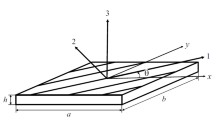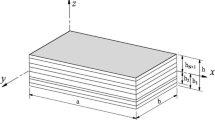Summary
This paper proposes a method for substantially improving the performance of the higher-order plate and shell theories in connection with the accurate stress analysis of homogeneous and laminated composite structural elements. The presentation of the method is based on the equations of the “general five-degrees-of-freedom” shear deformable plate theory. Since the method is entirely new, it is initially applied to the solution of the problem of simply supported plates deformed by cylindrical bending, for which there exists an exact elasticity solution [12]. Hence, its reliability is substantially validated by means of appropriate comparisons between numerical results based on the present plate theory and this exact elasticity solution. Moreover, the one-dimensional version of the present plate theory, employed for the cylindrical bending of plates, is considered as a general three-degrees-of-freedom shear deformable beam theory. This advanced beam theory is used for an accurate stress analysis of two-layered composite beams having one of their edges rigidly clamped and the other either rigidly clamped, free of tractions or simply supported. This final set of applications can be thought of alternatively as a stress analysis of two-layered plates deformed in cylindrical bending and subjected to several, different sets of edge boundary conditions.
Similar content being viewed by others
References
Reissner, E.: The effect of transverse shear deformation on the bending of elastic plates. J. Appl. Mech.12, A69-A77 (1945).
Mindlin, R. D.: Influence of rotatory inertia and shear on flexural vibrations of isotropic elastic plates. J. Appl. Mech.18, 31–38 (1951).
Yang, P. C., Norris, C., Stavsky, Y.: Elastic wave propagation in heterogeneous plates. Int. J. Solids Struct.2, 665–684 (1966).
Bhimaraddi, A., Stevens, L. K.: A higher order theory for free vibration of orthotropic, homogeneous and laminated rectangular plates. J. Appl. Mech.51, 195–198 (1984).
Reddy, J. N.: A simple higher-order theory for laminated composite plates. J. Appl. Mech.51, 745–752 (1984).
Soldatos, K. P.: On certain refined theories for plate bending. J. Appl. Mech.55, 994–995 (1988).
DiSciuva, M.: Bending, vibration and buckling of simply supported thick multilayered orthotropic plates: an evaluation of a new displacement model. J. Sound Vibr.105, 425–442 (1986).
Lee, K. H., Senthilnathan, N. R., Lim, S. P., Chow, S. T.: An improved zig-zag model for the bending of laminated composite plates. Compos. Struct.15, 137–148 (1990).
Savithri, S., Varadan, T. K.: Free vibration and stability of cross-ply laminated plates. J. Sound Vibr.141, 516–520 (1990).
Cho, M., Parmerter, R. R.: An efficient higher-order plate theory for laminated composites. Compos. Struct.20, 113–123 (1992).
Soldatos, K. P.: A transverse shear deformation theory for homogeneous monoclinic plates. Acta Mech.94, 195–220 (1992).
Pagano, N. J.: Exact solution for composite laminates in cylindrical bending. J. Compos. Mater.3, 398–411 (1969).
Srinivas, S., Rao, A. K.: Bending, vibration and buckling of simply supported thick orthotropic rectangular plates and laminates. Int. J. Solids Struct.6, 1463–1481 (1970).
Noor, A. K., Burton, W. S.: Stress and free vibration analyses of multilayered composite plates. Compos. Struct.11, 183–204 (1989).
Touratier, M.: An efficient standard plate theory. Int. J. Engng. Sci.29, 901–916 (1991).
Lu, X., Liu, D.: Interlayer slip theory for cross-ply laminates with nonrigid interfaces. AIAA J.30, 1063–1073 (1992).
Heuer, R.: Static and dynamic analysis of transversely isotropic, moderately thick sandwich beams by analogy. Acta Mech.91, 1–9 (1992).
Di Sciuva, M.: Multilayered anisotropic models with continuous interlaminar stresses. Compos. Struct.22, 149–167 (1992).
Cho, M., Parmerter, R. R.: Efficient higher order composite plate theory for general lamination configurations. AIAA J.31, 1299–1306 (1993).
He, J.-F., Chou, M., Zhang, X.: Bending analysis of laminated plates using a refined shear deformation theory. Compos. Struct.24, 125–138 (1993).
Ping, L., Yongwell, Z., Kaida, Z.: Bending of high-order refined shear deformation theory for rectangular composite plates. Int. J. Solids Struct.31, 2491–2507 (1994).
Lee, K. H., Lin, W. Z., Chow, S. T.: Bidirectional bending of laminated plates using an improved zig-zag model. Comp. Struct.28, 283–294 (1994).
Li, X., Liu, D.: Zigzag theory for composite laminates. AIAA J.33, 1163–1165 (1995).
Savoia, M.: On the accuracy of one-dimensional models for multilayered composite beams. Int. J. Solids Struct.33, 521–544 (1995).
Soldatos, K. P.: A general laminated plate theory accounting for continuity of displacements and transverse shear stresses at material interfaces. Compos. Struct.20, 195–211 (1992).
Soldatos, K. P.: A four-degrees-of-freedom cylindrical shell theory accounting for both transverse shear and transverse normal deformation. J. Sound Vibr.159, 533–539 (1992).
Soldatos, K. P.: Vectorial approach for the formulation of variationally consistent higher-order plate theories. Compos. Eng.3, 3–17 (1993).
Soldatos, K. P., Timarci, T.: A unified formulation of laminated composite shear deformable five-degrees-of-freedom cylindrical shell theories. Compos. Struct.25, 165–171 (1993).
Soldatos, K. P.: A non-linear transverse shear deformable plate theory allowing a multiple choice of trial displacement and stress distributions. Compos. Engng3, 885–897 (1993).
Soldatos, K. P.: Generalization of variationally consistent plate theories on the basis of a vectorial formulation. J. Sound Vibr.183, 819–839 (1995).
Levinson, M.: A novel approach to thick plate theory suggested by studies in foundation theory. Int. J. Mech. Sci.26, 427–436 (1984).
Jones, R. M.: Mechanics of composite materials. New York: Hemisphere 1975.
Timoshenko, S.: On the transverse vibration of bars of uniform cross-section. Phil. Mag.43, 125–131 (1922).
Bickford, W. B.: A consistent higher-order beam theory. Dev. Theor. Appl. Mech.11, 137–142 (1982).
Soldatos, K. P., Watson, P.: A general four-degrees-of-freedom theory suitable for accurate stress analysis of homogeneous and laminated composite beams. Int. J. Solids Struct. (in press).
Author information
Authors and Affiliations
Rights and permissions
About this article
Cite this article
Soldatos, K.P., Watson, P. A method for improving the stress analysis performance of one- and two-dimensional theories for laminated composites. Acta Mechanica 123, 163–186 (1997). https://doi.org/10.1007/BF01178408
Received:
Revised:
Issue Date:
DOI: https://doi.org/10.1007/BF01178408




